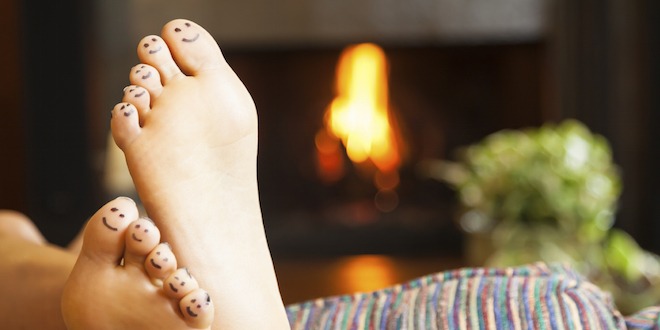Why are Canadian winters and proper foot care a concern for people with diabetes? Read on to learn how to protect yourself during frigid temperatures.
Foot ulcers are one of the most common and serious complications of diabetes, often leading to risk of amputation. In fact, compared to the general population, Canadian adults with diabetes are over 20 times more likely to undergo non-traumatic (i.e. not caused by an accident) lower limb amputations. Many of these could be avoided since 85% begin with a foot ulcer. This makes ongoing preventative foot care essential for people with diabetes, especially during the winter months.
Cold temperatures and dryness is hard on everyone’s feet, and can be particularly damaging for those with diabetes. Reduced blood flow to the extremities can lead to loss of feeling and can turn minor foot issues like blisters into serious wounds. Poor circulation can also result in swelling and can make dryness and cracking worse.
Special winter foot care guidelines
You should be checking your feet and following healthy foot care recommendations on a daily basis throughout the year. For more information, check out Proper foot care for people with diabetes in the Management section of this site. You may also be interested to read our article about physical activity and diabetes foot care.
During the winter months, some extra needs and concerns arise. In addition to regular foot care attention:
- Be extra vigilant in checking your feet every day. If it is difficult to view the soles of the feet, a hand mirror can be helpful. Check for sores, blisters, cuts, swelling, cracks, red areas and infected toenails.
- Apply moisturizing lotion to the tops and bottoms of the feet to help fight winter dryness. Avoid areas between the toes, which can harbor fungal infections.
- Avoid foot burns – don’t use heating pads or hot water bottles and don’t rest feet on radiators or close to heaters or fires.
- Wear clean, seamless socks at all times, even when indoors.
- Wear lined boots and avoid walking in snow whenever possible. Shake out shoes and boots before wearing, to make sure there are no pebbles or other objects inside.
- Maintain a regular program of physical activity to help improve blood flow to the feet.
Tips for buying diabetes-friendly footwear
- Buy shoes at the end of the day when feet are at their largest.
- Avoid plastic or vinyl footwear, which doesn’t ‘breathe’.
- Look for leather uppers with no inside seams. The inside of footwear should be soft and smooth with no hard or rough areas.
- Make sure shoes and boots are long enough. There should about 1.3 cm (½ inch) to spare at the end of the longest toes.
- Don’t forget that width is important too. Make sure the feet are not cramped at their widest point.
- To check for a correct fit, stand barefoot on a piece of paper. Have someone trace your foot outline. Next, trace the outline of the boot or shoe. By comparing the tracings, you can make sure there is ample room in the footwear.
- In some cases, special shoes or shoe inserts may be recommended. These may include depth shoes or custom made shoes with inserts. Your diabetes healthcare professional will advise you on how to get special footwear if it is required.
Tips to improve blood circulation to the feet
In addition to following a program of regular physical activity, people with diabetes can help to improve blood flow to the feet during the winter by following these simple tips:
- Avoid crossing the feet or legs.
- Avoid tightly fitting socks or socks with elastic tops.
- Wiggle the toes for about five minutes, at least two or three times each day.
- Move ankles up and down for a similar amount of time.
- Avoid smoking, which can have negative effects on blood circulation, especially to the feet. For help in quitting, see our article New Year’s resolution to quit smoking? Plan ahead to make it stick.
Signs you should call a healthcare professional
People with diabetes should have their feet carefully checked at every visit with their primary healthcare professional or foot doctor. In addition, a special appointment should be made if any of the following problems arise:
- Sores, wounds or blisters on the feet that don’t heal after a day or two
- Athletes foot
- Infection, including fungal problems
- Calluses, bunions or hammer toes
- Redness or skin blackening
- Ingrown toenails
- Numbness or unusual discomfort
- Prolonged itching
- Unusual swelling
 Diabetes Care Community Learn, connect and care
Diabetes Care Community Learn, connect and care





